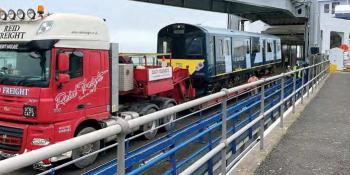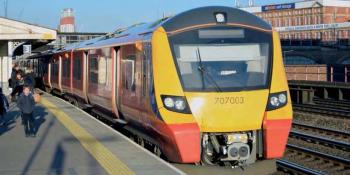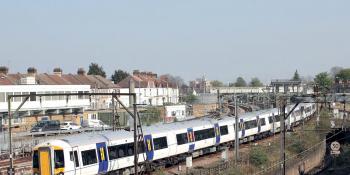Siemens makes it five UK rolling stock plants. Time to update the ‘kittens’ risk assessment
Informed Sources


Back in the December 2017 column, which feels like a very long time ago, I contrasted the aspirations for more rolling stock manufacturers to set up UK production facilities with an analysis of the likely demand. Since then, key orders have been awarded, clarifying the longer-term prospects for the various suppliers.
We are always being told that the railway is too insular and slow to adopt innovative ideas from outside the industry, so I must apologise for not alerting readers sooner to just such a transfer that is happening in the rolling stock market. ‘Pop-ups’, temporary shops, cafes and even cinemas and theatres, are all the rage. Currently, train builders, or rather assemblers, appear to be going with the zeitgeist.
Siemens, with the South West Trains Mk 1 stock replacement Desiro fleets, was an early ‘foreign’ entrant into the UK market, challenging the Alstom-Bombardier hegemony. That was 15 years ago, but despite winning further business, and already employing around 15,000 in its UK businesses, the German group held off from setting up a rolling stock assembly facility.
That reluctance has now vanished following the award of the contract for the Piccadilly Line replacement stock under Transport for London’s Deep Tube Upgrade Programme (DTUP, p16). The long hinted at new train assembly facility at Goole in Yorkshire is now a firm commitment.
Similarly, the award of the Wales and Borders franchise by the Welsh Government has also justified CAF’s commitment to build a new plant at Newport. Construction began in January and recruitment is underway. Around 200 will be employed when the plant opens later this year.
Nor should we forget Alstom’s new facility at Widnes. This is also providing a new home for what’s left of its traction equipment arm following the closure of the iconic Strand Road works at Preston, birthplace of the Blue Deltic (Oh, that sort of iconic – Ed).
Add in the existing sites – Bombardier at Derby and Hitachi at Newton Aycliffe – and we have five assembly plants currently or soon to be assembling passenger rolling stock for the UK market. Or potentially – in the case of Widnes.
Meanwhile, my old chum Jon Veitch is still scouring the country looking at potential sites for a facility to assemble Talgo trains for the UK market. And even Vivarail has got in on the act with a new £100,000 shadow plant at Seaham in County Durham. This is assembling power packs and wiring looms for the D Train multiple-units.
WORKLOAD
So now we have a clearer idea of the workloads at these plants. And, more importantly, the potential contracts available to keep them occupied when the current builds expire.
Bombardier at Litchurch Lane remains the nearest to what those of a certain age would term a ‘factory’, with a full blown design office, limited manufacture on site and a test track. That said, much of the high value equipment, such as traction packages and bogies, are imported – but that is the way of the modern world.
All the rest are ‘pop-ups’ to varying degrees. All you need to start assembly is plenty of land and one of those large steel-clad sheds you see on industrial estates and out-of-town retail parks and, bingo, you are ready to start installing handling plant, pitted roads, lifting and craneage, recruit the staff and start assembling.
KITTENS
Of course, you have now created a facility that for long-term survival will need to be fed with a steady supply of new contracts, in a market now past peak ‘new train’. And as we have seen in recent years, even when just Bombardier and Hitachi formed the domestic industry, the threat of factory closure has become a marketing tool when faced with outside competition.
So with five domestic plants, we can expect more pleas of ‘Give us an order or the kitten gets it’ during the bidding rounds for the South Eastern, East Midlands and Cross Country franchises. This explains the photo of five cute kittens in a railway trade and technical magazine. For the record, their names are Taff, Almost, Litchurch, Tyke and Geordie.
These three franchises, together with the West Coast Partnership, are all due to be let by December 2019. And while the Rail Delivery Group’s latest Long Term Passenger Rolling Stock Strategy annual forecast identifies a requirement for between 11,000 and 16,000 new EMU vehicles by 2046, for the train builders five years is ‘long term’ when it comes to contracts.
So what brands of kitten food are coming onto the pet shop shelves (I think this has gone too far – Ed). Sorry, so what is the likely future demand to keep these factories occupied when the initial workload runs out? (Better – Ed.)
SOUTH EASTERN MINI-BONANZA
Detailed tables appeared in the December column, but briefly, the most immediate opportunity is the South Eastern Networkers that are universally expected to be replaced by the incoming operator. That represents 674 vehicles, which would keep a couple of production lines running for around 30 months.
There had been talk of a classic total extinction extending to the Electrostar fleets. However, that may be a total extinction too far, even for Franchise Director Peter Wilkinson’s desire to raise passenger standards.
ALSTOM INITIATIVE
An historically-minded reader has pointed out that the award of the Deep Tube Upgrade Contract to Siemens means Alstom has not won a UK rolling stock order in open tender during the 20 years between the Group’s flotation in 1998 and its coming merger with Siemens. The Virgin Trains Pendolino contract was won by GEC Alsthom, with an ‘h’, in February 1998.
In those two decades I have interviewed successive Alstom UK Chief Executives who have listed their ‘must win’ UK contracts. All to no avail.
So now we have a new approach, with Stagecoach announcing in February that Alstom Transport UK Ltd would be joining its bid for South Eastern. Should Stagecoach win the franchise, Alstom would hold 20% of the share capital of the train operating company.
This is about more than trains. Alstom in the UK is also active in a range of railway infrastructure disciplines, notably signalling and electrification.
Although it’s another DfT bonkers idea, for reasons explained in earlier columns, the South Eastern franchise Invitation To Tender required bidders to price the provision of Traffic Management (TM) at Ashford Integrated Electronic Control Centre (IECC). As Alstom’s Iconis TM didn’t make it past Network Rail’s demonstration suite stage, I suppose it could be their turn.
According to Stagecoach Chief Executive Martin Griffiths, the proposed arrangement ‘supports our vision of delivering a more integrated and innovative rail service’. As a partner in the Virgin Trains West Coast joint venture, Stagecoach has experience of an existing Alstom ‘supply and maintain’ scheme in the form of the Class 390 Pendolino fleet. I’d better not mention the Alstom Class 458 Juniper experience!
Nick Crossfield, Managing Director, Alstom UK & Ireland, saw the arrangement as an ‘opportunity to form an even closer partnership’. And while it is a win-or-bust deal, for Alstom, ‘nailing the flag to the Stagecoach mast’ has practical benefits.



First, it cuts out the waste of preparing offers for multiple franchise bidders, each to a different specification. But, most important, is the synergy of developing a train specification and maintenance regime in partnership with an operator, and one that has traditionally been heavily focused on rolling stock.
So while Almost, sorry, Widnes, is not at risk, because it hasn’t got any assembly work, it could become a fully-fledged kitten with a grown-up order book. But, as explained later, the South Eastern order will be very fiercely contested.
EAST MIDLANDS
This does look like another mass extinction, with the IC125s to go plus the Class 222 Meridians. According to informed sources, DfT still can’t kick its new trains habit and is insisting that a revival of ‘Project Thor’ is streng verboten.
That proposal emerged the last time Bombardier was in kitten threat mode. The aim was to add a pantograph/transformer car to the Meridians to create a high performance bi-mode. This was technically feasible because the Meridian is a diesel-electric multiple-unit (DEMU) with Alstom traction equipment.
Note that DfT, well, Transport Secretary Chris Grayling, has specified bi-modes on the East Midlands inter-city service by/from 2022. With around 250 vehicles to be replaced this might seem like a godsend for Hitachi.
However, as reported in the last issue (p76), Bombardier will be offering what it claims will be a full-on 125mph Aventra bi-mode. Hitachi reckons that an extra engine under a Class 800 would give parity in this power race.


OPTIMUM
In the real world, as this column has been pointing out for decades, and Mr Walmsley restated last month, at five coaches and above, loco haulage trumps underfloor engines. A power car also has practical technical benefits.
As the Great Western Class 800 fleet, and the odd Class 180, demonstrated in the recent heatwave, fitting a high power diesel engine module under the floor within the British loading gauge leaves little margin when it comes to cooling capacity. In contrast, a power car has lots of height and length to accommodate generously sized cooler groups, as supplied by Messrs Brush and Voith for re-engined Class 43 traction units.
Also to be let in 2019 is Cross Country. Here too, the word is ‘Voyagers delenda est’, as Cato the Elder was wont to declare in the Senate when he was the head of the Imperial Roman Railways Franchise Directorate. So that is another 300 or so bi-mode vehicles.
WEST COAST
Finally, of course, we have the new fleet of Classic Compatible trains for High Speed 2. With Siemens and Alstom merging and Bombardier and Hitachi forming another joint venture, this time to provide an ‘iconic’ train, ‘a Spitfire for the British railway’, the field has diminished. Fortunate for HS2, then, that CAF was so vexed by its failure to make the cut that, according to informed sources, it went to judicial review and has been ‘welcomed’ back into the game.
With the new Very High Speed Trains being procured by HS2 due to be ordered in December next year, that is not going to put work into factories this side of 2022 at the earliest. However, bidders for the West Coast Partnership, which will combine HS2 and Inter-city West Coast services, will have to decide what to do about Pendolino for the long term, analysed in previous columns, plus the Class 221 tilting Voyagers.
Pendolino is protected by a Section 54 agreement until March 2022. However, the Section 54 for the 100 Class 221 vehicles runs out in March next year.
In total this gives a potential market for 650 Class 22x replacement vehicles for delivery from around 2022. These remain subject to a range of imponderables, possibly even an outbreak of common sense. But it does explain why Bombardier has put time and money into its bi-mode Aventra.
WORKLOAD ANALYSIS
Siemens’ new plant at Goole is the smuggest kitten around. Delivery of the Piccadilly Line replacement trains is not due to start until 2023 and then runs to 2026. And, subject to good behaviour, the same design will keep rolling off the line into the 2030s. This gives ample time to plan what the facility will do and, hopefully, progressively crank up UK content.

There is, however, a big imponderable. Suppose the Siemens-Alstom combination wins the HS2 contract. There will be pressure for UK content. Does the Franco-German combo expand Widnes, restart UK manufacture of high value traction equipment? Run complementary lines at Goole and Widnes? Who can tell, but what an imponderable to have on the boardroom table.
CAF at Newport has work for Wales and Borders until 2022 and may assemble later deliveries of some of its other UK contracts at the new facility. While 2022 is four years away, if the plant is not to be a pop-up, it will need more work and the only EMU show in town is South Eastern.
However, CAF is back in the mix for HS2. So Taff is purring hopefully.
Bombardier has dominated recent EMU contracts with the Aventra. Derby now has firm orders for more trains than the three other builders with UK plants put together.
However, the order book is matched by a high production rate, which means that more work will be needed from 2021. A lot more work given that Derby is a very hungry kitten. So either South Eastern or a launch order for the Aventra bi-mode is needed.
Finally we have Hitachi, where the much-vaunted new plant at Newton Aycliffe is the kitten most at risk. Apart from the remainder of the ScotRail Class 385 fleet, the plant is wholly dependent on the Inter-city Express Programme (IEP) contracts.
IEP BY NUMBERS
A note here on IEP numbering used in the two Master Availability & Reliability Agreements (MARA) for Great Western and what we must now call London North Eastern Railway (LNER). The train numbers refer to the acceptance schedule and not works number.
Great Western’s five-car bi-modes are Trains 1 to 36. Contractually Train 36 was due to have been accepted on 8 February 2018, with deliveries on nine-car continuing at nominally one per week until 6 July this year. As we know, late commissioning of the first electrified section of the Great Western main line, which was to be used for testing, meant that acceptance was delayed by three months.
Initially ordered as pure electrics, but subsequently changed to bi-modes, the Great Western nine-car IETs follow-on in the numbering system as Trains 37-57. Train 44 (No 800308) has just arrived.
LNER IEP deliveries start with the 13x9-car bi-modes which will replace IC125. These are numbered Trains 58-70 and under the original MARA were due to be accepted between 23 August and 15 November this year. In line with the three-month delay, Train 58 is now scheduled for 19 November.
However, it appears to have taken longer than expected to build up to the production beat (the frequency at which trains move along the production line) at Newton Aycliffe. As a result, manufacture of 20 IEP sets has been transferred to Hitachi’s home plant at Kasado in Japan.
Note, too, that the Class 802 bi-modes for GWR, TransPennine Express and Hull Trains are being built at Hitachi’s former Ansaldo plant at Pistoia in Italy. At the time these orders were received Italian production was attributed to Newton Aycliffe being too busy.
From the latest delivery schedule it looks as though the initial run of nine-car sets in the 20 Kasado-built trains are being delivered in alternate weeks. One reason for this could be that while Newton Aycliffe can turn out one five-car unit a week, nine-cars trains are taking longer.

Supplementing Newton Aycliffe’s output in this way is maintaining delivery at the contractually-agreed 12 weeks’ delay dates. Assuming this continues, the last IEP will leave Newton Aycliffe at the end of March 2020.
So for Hitachi, South Eastern or the EMT bi-modes is a must win. Either could be met with existing products.
PEOPLE
Behind these cold numbers and talk of ‘pop-ups’ we must never forget that a factory is just a building full of stuff until the people arrive. And these new assembly plants are being built in locations where steady jobs are hard to find.
When writing on this topic, always at the back of my mind is a visit to the new Thrall wagon factory at York, opened to meet the demand from the new private freight operator English, Welsh & Scottish Railway. The commitment and belief among the workforce was touching. When I expressed doubts about long-term demand to an engineering chum, it was clear that she had bought the dream too.
But when the initial EWS orders were completed, the factory closed. So it’s not really about cute kittens, but people and their families.






